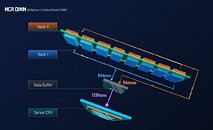- Joined
- Aug 19, 2017
- Messages
- 3,260 (1.13/day)
AMD and JEDEC are collaborating to create a new industry standard for DDR5 memory called MRDIMMs (multi-ranked buffered DIMMs). The constant need for bandwidth in server systems provides trouble that can not easily be solved. Adding more memory is difficult, as motherboards can only get so big. Incorporating on-package memory solutions like HBM is expensive and can only scale to a specific memory capacity. However, engineers of JEDEC, with the help of AMD, have come to make a new standard that will try and solve this challenge using the new MRDIMM technology. The concept of MRDIMM is, on paper, straightforward. It combines two DDR5 DIMMs on a single module to effectively double the bandwidth. Specifically, if you take two DDR5 DIMMs running at 4,400 MT/s and connect them to create a single DIMM, you get 8,800 MT/s speeds on a single module. To efficiently use it, a special data mux or buffer will effectively take two Double Data Rate (DDR) DIMMs and convert them into Quad Data Rate (QDR) DIMMs.
The design also allows simultaneous access to both ranks of memory, thanks to the added mux. First-generation MRDIMMs can produce speeds of up to 8,800 MT/s, while the second and third generations modules can go to 12,800 MT/s and 17,600 MT/s, respectively. We expect third-generation MRDIMMs after 2030, so the project is still far away. Additionally, Intel has a similar solution called Multiplexer Combined Ranks DIMM (MCRDIMM) which uses a similar approach. However, Intel's technology is expected to see the light of the day as early as 2024/2025 and beyond the generation of servers, with Granite Rapids likely representing a contender for this technology. SK Hynix already makes MCRDIMMs, and you can see the demonstration of the approach below.


View at TechPowerUp Main Site | Source
The design also allows simultaneous access to both ranks of memory, thanks to the added mux. First-generation MRDIMMs can produce speeds of up to 8,800 MT/s, while the second and third generations modules can go to 12,800 MT/s and 17,600 MT/s, respectively. We expect third-generation MRDIMMs after 2030, so the project is still far away. Additionally, Intel has a similar solution called Multiplexer Combined Ranks DIMM (MCRDIMM) which uses a similar approach. However, Intel's technology is expected to see the light of the day as early as 2024/2025 and beyond the generation of servers, with Granite Rapids likely representing a contender for this technology. SK Hynix already makes MCRDIMMs, and you can see the demonstration of the approach below.


View at TechPowerUp Main Site | Source








